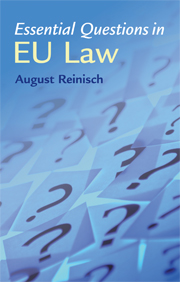Book contents
- Frontmatter
- Contents
- List of abbreviations
- Preface
- 1 History of European integration
- 2 The institutional framework
- 3 The making of Community law
- 4 The effect of Community law
- 5 Judicial control within the Community
- 6 Protecting fundamental rights within the Community
- 7 The free movement of goods
- 8 The free movement of persons
- 9 EC competition law
- 10 Selected Community policies
- 11 The EC and the EU as international actors
- Index
8 - The free movement of persons
Published online by Cambridge University Press: 05 June 2012
- Frontmatter
- Contents
- List of abbreviations
- Preface
- 1 History of European integration
- 2 The institutional framework
- 3 The making of Community law
- 4 The effect of Community law
- 5 Judicial control within the Community
- 6 Protecting fundamental rights within the Community
- 7 The free movement of goods
- 8 The free movement of persons
- 9 EC competition law
- 10 Selected Community policies
- 11 The EC and the EU as international actors
- Index
Summary
In addition to the effective implementation of the free movement of goods, characteristic of a customs union, the Community has always aimed at guaranteeing the free movement of persons in order to create a true internal market. This ‘internal market’ is defined in Article 14(2) TEC as ‘an area without internal borders in which the free movement of goods, persons, services and capital is ensured’. The history of the EC/EU is the history of the gradual implementation of these so-called four freedoms which follows a similar regulatory pattern, that is, ensuring non-discrimination and eliminating intra-Community restrictions by Member States.
This chapter will provide an overview on the Community rules on the free movement of natural and legal persons, that is, individuals and companies. They originate in three sets of Treaty provisions: the free movement of ‘workers’; the freedom of establishment; and the freedom to provide services. The resulting, rather narrow economic rights have been broadened through the case law of the ECJ and secondary Community legislation, which has almost led to a general right of free movement. The Luxembourg Court did so by broadly interpreting the entitlements contained in Treaty provisions and by gradually restricting the powers of Member States to limit these rights.
Is there a general right to free movement for all EU citizens?
The Maastricht Treaty introduced the concept of Community citizenship which, according to Article 17 TEC, derives from and complements the nationality of the Member States.
- Type
- Chapter
- Information
- Essential Questions in EU Law , pp. 124 - 155Publisher: Cambridge University PressPrint publication year: 2009



